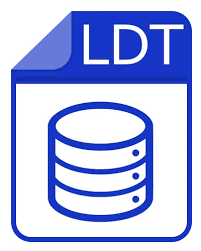Introduction
The LDT file in LED lighting design is one of the most critical data formats used across the lighting industry. If you have ever worked on lighting projects, simulations, or product modeling, you’ve likely encountered this file format. But what exactly is an LDT file, and why does it matter so much in modern lighting design?
This article explores everything you need to know about LDT files — from their technical role to practical benefits in LED projects, software compatibility, and how they compare with other photometric file formats. By the end, you’ll understand why the LDT file is considered a key standard in the global lighting industry.
What is an LDT File?

An LDT file (Eulumdat format) is a photometric data file widely used in Europe and internationally for describing the light distribution of a luminaire. It contains precise measurements that show how light is emitted from a fixture in different directions.
Key characteristics of LDT files include:
- Photometric data: Details of luminous intensity distribution.
- Fixture properties: Technical details like luminaire dimensions, lamp types, and luminous flux.
- Measurement standards: Based on the C-plane system, ensuring uniformity and compatibility across platforms.
Due to these attributes, LDT files enable lighting designers, architects, and engineers to make accurate predictions in simulation software prior to actual installation.
Why LDT Files Are Essential in LED Lighting Design
The shift toward LED lighting has increased the demand for precise photometric data. LEDs come in a wide variety of shapes, sizes, and distributions, making simulation data essential.
Benefits of LDT files in LED lighting design:
- Simulation accuracy – Designers can predict brightness, glare, and energy usage.
- Time savings – Prevents costly mistakes by validating performance before installation.
- Standardization – The LDT format ensures that data from different manufacturers can be compared fairly.
- Compatibility – Works seamlessly with most lighting design tools such as DIALux, Relux, and AGi32.
- Transparency – Provides detailed product information, improving trust between manufacturers and end-users.
👉 For more on photometric data standards, see DIALux’s official documentation.
LDT vs. IES: Comparing Two Key Photometric Formats
While LDT is widely used in Europe, the IES format dominates in North America. Both formats serve the same purpose but follow different standards.
| Feature | LDT File (Eulumdat) | IES File |
|---|---|---|
| Region | Europe & International | North America |
| System | C-plane (CIE standard) | B-plane (IESNA standard) |
| Detail Level | Highly structured | Flexible but varied |
| Software Support | DIALux, Relux, AGi32 | AGi32, Visual, Photometric Toolbox |
Many modern software solutions allow importing both LDT and IES files, ensuring global interoperability.
Structure of an LDT File
An LDT file in LED lighting design follows a strict structure, making it readable by design software. Some of the common data points include:
- Luminaire description: Model name, manufacturer, lamp type.
- Geometry: Dimensions of the luminaire.
- Photometric details: Luminous flux, luminous intensity distribution.
- Measurement setup: Position of lamps, number of lamps, tilt angle.
Here’s an example snippet from an LDT file:
[MANUFAC] Philips Lighting
[MODEL] LED Panel 600x600
[LAMPCOUNT] 1
[LUMEN] 3200
[INTENSITY VALUES] …
This structured approach makes the LDT format easy to parse and universal across different projects.
Applications of LDT Files in LED Lighting Design
The LDT file in LED lighting design plays a pivotal role in multiple stages of a project:
1. Architectural Lighting
- Helps simulate lighting in offices, malls, stadiums, and streetlights.
- Ensures compliance with brightness and safety standards.
2. Product Development
- Manufacturers release LDT files so customers can test performance digitally.
- Reduces the need for physical samples.
3. Energy Optimization
- LDT data helps compare products by efficiency.
- Ensures sustainable design practices.
4. Compliance & Certification
- Standards organizations and green building programs often require photometric proof.
- LDT files act as official documentation of product performance.
Tools & Software for Working with LDT Files

If you’re working on LED projects, you’ll likely encounter one of the following software tools:
- DIALux – Free lighting design software popular in Europe.
- Relux – Offers detailed calculations and simulations.
- AGi32 – Advanced professional-grade lighting simulation tool.
- Autodesk Revit – Supports LDT imports for BIM workflows.
👉 Check out Relux’s official site for tutorials on importing LDT files.
How to Open and Use LDT Files
Opening and using LDT files is straightforward:
- Download the LDT file from a manufacturer’s website.
- Import it into your design software (e.g., DIALux, Relux).
- Run simulations to test brightness, uniformity, and efficiency.
- Adjust layouts based on simulation results.
This process eliminates guesswork and ensures that the installed lighting system will perform exactly as expected.
Common Challenges with LDT Files
While LDT files are powerful, designers may face challenges such as:
- Incorrect data entries – Errors in manufacturer files can lead to inaccurate results.
- Limited flexibility – Compared to IES, LDT is more rigid.
- File corruption – Rare but possible when transferring files.
Best practice: Always download LDT files directly from the manufacturer’s official website to ensure accuracy.
Future of LDT Files in LED Lighting Design
As LED technology evolves, the LDT file in LED lighting design will continue to be central to global projects. However, new trends are emerging:
- Integration with BIM (Building Information Modeling) – Making data exchange seamless.
- Cloud-based libraries – Centralized access to verified LDT files.
- Smart lighting compatibility – Future LDT specifications may include IoT-related metadata.
This evolution ensures that LDT remains a reliable, trusted format for professionals worldwide.
Conclusion
The LDT file in LED lighting design is not just a technical specification — it’s a foundation for accuracy, efficiency, and sustainability in the modern lighting industry. From architectural projects to product development, this format empowers professionals to make data-driven decisions with confidence.
By understanding how to use LDT files, comparing them with alternatives like IES, and leveraging them in design software, lighting designers can unlock smarter, safer, and more efficient projects.
👉 Whether you’re an architect, engineer, or manufacturer, mastering the LDT file in LED lighting design is essential for success in the global lighting market.




